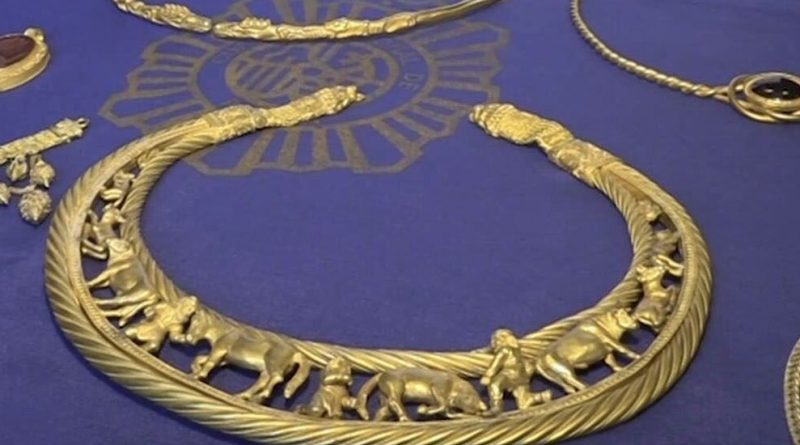Ukrainian ‘Artifacts’ Seized in Spain May Not Be Treasures, Experts Say
[ad_1]
To the police in Spain, the artifacts possessed an ancient and golden allure.
In a criminal investigation, the Spanish police said on Monday, officers had found that 11 pieces of gold, believed to date as far back as the 4th and 8th centuries B.C., had been stolen from Ukraine in 2016 and illegally taken to Madrid, where five people schemed to sell the artifacts.
The five individuals were arrested and charged with money laundering, and the national police released images and video of the stolen items, saying that their value was around 60 million euros, or $64 million.
But two experts in Greco-Scythian artifacts said in interviews that the items seized are most likely modern imitations of those crafted by ancient Greeks for Scythian nomads who, in the 4th century B.C., traversed what is now Ukraine and southern Russia.
Leonid Babenko, an archaeologist at the M.F. Sumtsov Kharkiv Historical Museum in Kharkiv, Ukraine, said in an email that the items were “clumsy fakes” and had most likely been created for private collectors.
“In terms of style and subject matter, this is an inept imitation of well-known products,” Mr. Babenko said.
Caspar Meyer, an archaeologist who has written a book on Greco-Scythian art and is a professor of ancient Greece and Eurasia at the Bard Graduate Center in New York City, said in an interview that the items seized are imitations, and that he was unsure of how the Spanish authorities had arrived at their valuation in euros.
“If they were genuine, they would be probably more than 60 million because there is so little of this material, it’s priceless,” Dr. Meyer said. “There is no precedent on the art market to value something like this.”
Dr. Meyer said that there are only about 30 to 40 major Greco-Scythian artifacts that have been recovered because they are so difficult to excavate. The pieces are usually buried more than 60 feet underground and under vaults of sorts that only archaeological excavation organizations can dig into.
“There is actually very, very little material of this in private hands,” Mr. Meyer said. “It’s almost all in big museums.”
The Spanish police did not immediately respond to an email seeking comment on Tuesday. In its news release about the seized items, the police said that the National Archaeological Museum in Madrid would be studying the pieces. The museum did not immediately respond on Tuesday to an email seeking comment.
The uncertainty over the legitimacy of the items highlights the dubious cloud that often hangs over the world of private collecting of antiquities and artifacts, with documents sometimes being forged and collectors falling for fabricated products.
In this case, the Spanish police said that the three Spaniards and two Ukrainians who were arrested had taken “cultural property” belonging to Ukraine and attempted to sell it in Madrid. The suspects have not been named by the authorities.
The police said their investigation had begun when officers learned that a Ukrainian citizen was trying to sell gold jewelry through unofficial channels, not auction rooms. The police did not say exactly when the investigation started.
In order to “whitewash” the origins of the pieces, the police said, the accused individuals wrote documents in Ukrainian, English and Spanish to prove that they had belonged to the Ukrainian Orthodox Church, the police said.
It is unclear if the five people charged were aware that the items were fake, or if they believed that the golden jewelry was truly ancient. The police said that Spanish experts in “cultural property” had appraised the artifacts at a value of more than €60 million.
A gold item with rams’ heads that had been privately sold to a Madrid businessman was the first item to be seized by investigators in 2021, the police said.
One of the Ukrainians arrested was an Orthodox Church priest who falsified documents about the origin of the items. The Spanish Police believe that the items were held in a museum in Kiev from 2009 to 2013 and were illegally taken from there in 2016. Officials did not name the museum.
Mr. Meyer said that he believes he saw the items at a private collection in a church building in Kiev in 2011, and that he believed then that they looked strange.
“I didn’t engage with them in my academic work because I was pretty sure that they were modern imitations,” he said.
For example, one of the items, a gold pectoral, appears to essentially be in perfect condition in the video posted by the Spanish police on social media. But a similar pectoral that is housed in the Museum of Historical Treasure in Kyiv is considered authentic and has been regarded as “the most prominent and esteemed of all the finds uncovered in 260 years of excavating the Scythian kurgans,” said Mr. Babenko, who has studied that particular artifact.
Dr. Meyer said that “despite the questionable authenticity of the pieces,” they should be returned to Ukraine “for proper study” and to understand how the items were created.
[ad_2]
Shared From Source link Arts
